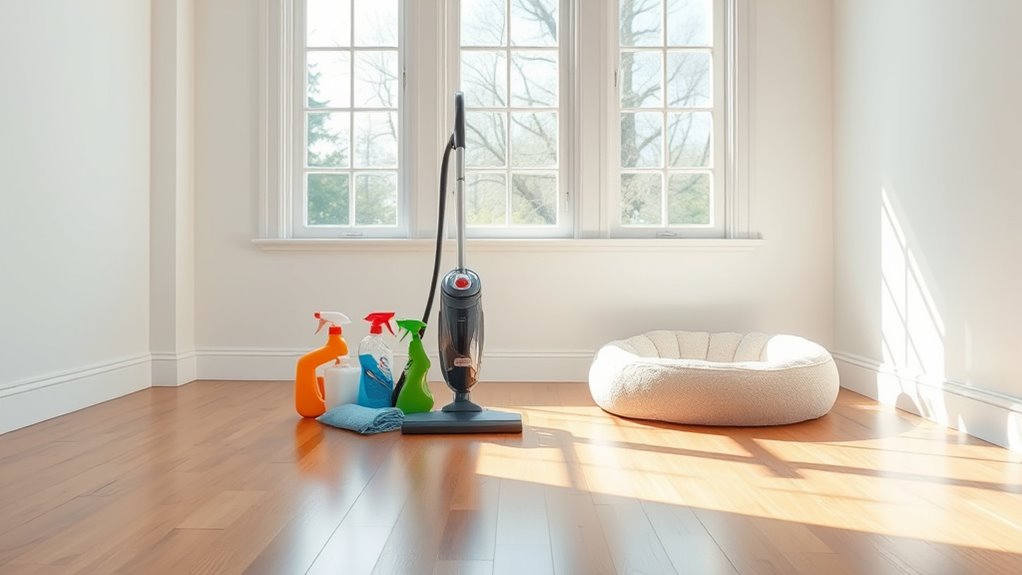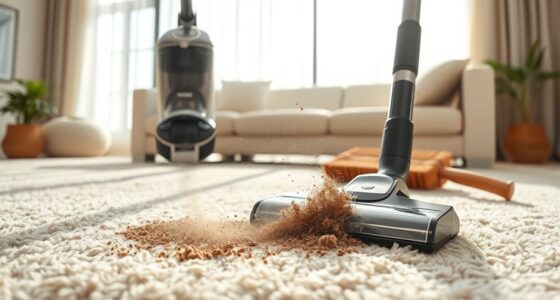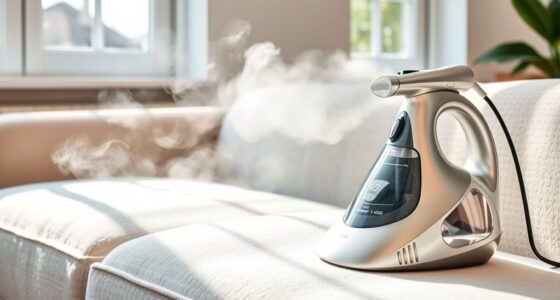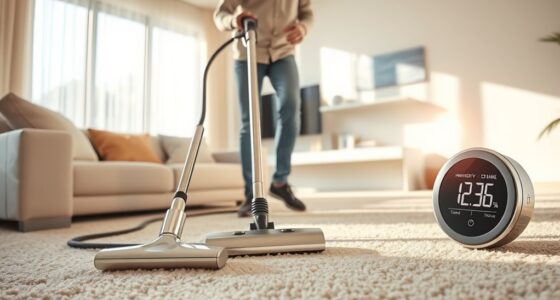To set up a pet-free cleaning zone, choose a specific room and establish clear boundaries using gates or closed doors. Equip the space with a HEPA-filter vacuum and microfiber cloths for effective allergen capture. Regularly declutter, wipe surfaces, and vacuum high-traffic areas to keep allergens low. Invest in air purifiers and washable textiles, and maintain a strict cleaning schedule. By following these steps, you’ll create a healthier environment. Find out more tips for sustaining your pet-free zone!
Key Takeaways
- Choose a designated room to create a pet-free cleaning zone, ensuring it allows for focused cleaning and minimal allergen exposure.
- Use a HEPA filter vacuum and microfiber cloths to effectively capture pet hair and allergens during cleaning.
- Regularly declutter surfaces and wipe them down with all-purpose cleaner to reduce dust and allergen buildup.
- Incorporate air purifiers and washable fabrics to enhance air quality and facilitate easy allergen removal.
- Maintain a consistent cleaning schedule and enforce boundaries to keep the space free from pet access.

Creating a pet-free cleaning zone can make a significant difference in maintaining a fresh and tidy home. By designating specific areas where your pets aren’t allowed, you can streamline your cleaning routine and tackle issues like pet hair removal and allergen control more effectively. This approach keeps your living space more organized and ensures that you can breathe easier, especially if you or anyone in your household has allergies.
Start by choosing a room or area that you’ll keep pet-free. It could be your bedroom, a home office, or even a designated cleaning space. Make sure it’s a place where you can focus on cleaning and tidying without distractions. You’ll want to set clear boundaries for your pets, so consider investing in baby gates or using closed doors to keep them out. This way, you can concentrate on cleaning without worrying about pet hair drifting in or allergens being stirred up.
Next, equip your cleaning zone with the right tools for pet hair removal and allergen control. A high-quality vacuum cleaner with a HEPA filter is essential for capturing microscopic allergens and dander. Make it a habit to vacuum regularly, targeting corners, rugs, and upholstery where pet hair tends to accumulate. Additionally, using microfiber cloths can help trap dust and allergens more effectively than traditional cleaning cloths.
When you’re ready to clean, remember to declutter first. Keeping surfaces clear will not only make your cleaning process faster but also minimize the chances of allergens hiding in piles of items. Wipe down surfaces with an all-purpose cleaner, and don’t forget to dust light fixtures and shelves. The cleaner your space, the fewer allergens will linger.
Once you’ve finished cleaning, consider adding air purifiers to your pet-free zone. They help filter out allergens and pet dander, improving air quality. You might also want to use washable throw blankets and curtains that can be easily laundered to reduce the buildup of allergens. Additionally, maintaining a designated cleaning space can help you stay focused and efficient during your cleaning routine.
Finally, maintain this pet-free cleaning zone by sticking to a regular schedule. Whether it’s weekly or bi-weekly, consistency is key. By taking these steps, you’ll create a healthier environment that’s easier to manage, allowing you to enjoy your space without the hassle of pet-related messes and allergens. So, go ahead, set up your pet-free cleaning zone, and experience the difference it makes in your home!
Frequently Asked Questions
How Can I Keep My Pets Out During Cleaning?
To keep your pets out during cleaning, use pet barriers to block off areas you’re working in. You can set up baby gates or use furniture to create a temporary barrier. Additionally, consider using pet deterrents like sprays or noise devices to discourage them from entering those zones. A little training goes a long way, too—reward your pets for staying away while you clean, and they’ll learn to respect the boundaries!
What Cleaning Products Are Safe for Pets?
When you’re choosing cleaning products, look for pet safe cleaning options like vinegar, baking soda, and lemon juice. These natural ingredients are effective and non-toxic disinfectants that won’t harm your furry friends. You can also find commercial products labeled as safe for pets; just check the ingredients. Avoid harsh chemicals to keep your home clean and your pets healthy. Remember, a clean space doesn’t have to mean a toxic one!
Can I Train My Pet to Stay Away?
Yes, you can train your pet to stay away from certain areas. Start by using positive reinforcement techniques, rewarding them for staying in designated spots. Consistently practice commands like “stay” or “leave it” to shape their behavior. Make the area less accessible by using barriers or gates. Over time, with patience and consistency, your pet will learn to respect your cleaning zone, making it easier for you to maintain a tidy space.
How Often Should I Clean the Pet-Free Zone?
Cleaning your pet-free zone should feel as regular as brushing your teeth—essential for a healthy life. Aim for at least once a week to effectively manage pet hair removal and allergen control. If you notice extra shedding or allergy symptoms, consider increasing the frequency. Regular vacuuming, dusting, and washing surfaces will keep the area fresh, ensuring it remains a safe haven for you and your guests. Your well-being’s worth the effort!
What Areas Should I Designate as Pet-Free Zones?
You should designate areas like the kitchen, dining room, and bedrooms as pet-free zones. These spaces benefit from solid pet proofing strategies, ensuring cleanliness and minimizing allergens. Use zone signage to clearly mark these areas, reminding everyone to keep pets out. By doing this, you’ll create a more comfortable environment for guests and family members who may have allergies, and maintain a tidier home overall.
Conclusion
By creating a pet-free cleaning zone, you’re not just keeping your space tidy; you’re safeguarding your health and sanity. Imagine walking into a room where the air feels fresh, and the surfaces gleam—no fur, no dander, just a clean slate. But what if the next time you step into that pristine zone, you stumble upon a hidden mess? Stay vigilant, and maintain that sanctuary. After all, you never know what surprises await when you let your guard down.









